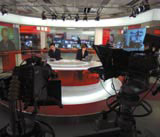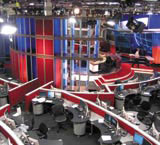Makeover culture makes news
As TV channels proliferate, Sarah Balmond looks at their efforts to suck in viewers with elaborate, action-packed sets and multimedia content
The news is much in the news at the moment. Aside from the after-hours exploits of newspaper editors and the u

As TV channels proliferate, Sarah Balmond looks at their efforts to suck in viewers with elaborate, action-packed sets and multimedia content
The news is much in the news at the moment. Aside from the after-hours exploits of newspaper editors and the uncertain fate of channels like ITV News, the launches of new channels like ITV 4 and More 4 are grabbing the headlines.
But the way news is gathered and distributed has faced big changes in the past decade and so too have the set designs for most of the major TV broadcasters.
The BBC, ITV, Channel 4, Five and Sky News have all recently collaborated with designers to revamp their national and regional studios, in attempts to gain brand recognition, attract viewers and respond to evolving technology.
These days, viewing the news is a more of an interactive experience, with presenters sitting alongside floating graphics, projected images, animations and rotating desks. Design cues are being borrowed from the US market and studios are producing more and more stateside-style glamour and high-octane theatre. Drama and a frenetic atmosphere is replacing the once calm scenario of a placid presenter reading the news, as broadcasters attempt to outdo each other in efforts to implement the most sophisticated and integrated set design.
Sky News has just unveiled its new look, created by Jack Morton Worldwide’s production design group (DW 3 November). The team was tasked with super-sizing the Isleworth-based studio into an ‘impressive’ studio, more akin to those of the major American networks, such as NBC and HBO.
For the first time, Sky News has integrated the newsroom with its studio, doubling the news wall to produce what it claims is one of the biggest LED screens to be used on TV. The main presentation desk rotates and is installed with a purpose-built screen that mirrors images from the news wall.
‘We went to the States because there was nothing like their newsrooms here in the UK,’ says Jon Bennett, head of studio output for Sky News, who has been overseeing the revamp. ‘Gone are the days of having presenters and journalists [in separate places].’
He says the newly-designed studio ‘allows you to see journalists rushing around like headless chickens when David Blunkett resigns, for example. It can be risky for noise, however, for example if you hear someone chortle in the background over the death of the Pope,’ says Bennett. The redesign helps position Sky as a ‘serious player’ and sends out a ‘fundamental message’, he adds.
Jim Fenhagen, senior vice-president at Jack Morton Worldwide, has worked on similar projects, including the redesign of the Five News set to ‘come up with a signature look and a wow factor which distinguishes them visually’. He is currently designing studios for sports channel TSN in Toronto and India Today.
He believes that international set design has grown in importance as the marketplace becomes more cluttered. While he thinks consumers can handle more information and graphics on-screen, he warns of being ‘over the top’ and advocates a simpler, sleeker, more modern design that can also be ‘energetic.’ He also notes that British studio set design is influenced by trends in modern architecture.
The growing use of high-definition camera technology means studios are being redesigned with a greater attention to detail, to avoid looking ‘scruffy and ratty’. More raw materials are being manipulated on set: metal finishes or inlay tile floors are being used instead of faux painting, for example.
Fenhagen also points to the growing breed of ‘virtual’ studios, where the entire space is a green-screen filled with projections and graphics, broadcast in real-time, but warns, ‘This has not yet reached its potential – currently it can look quite fake.’
The BBC overhauled its national and News 24 studios, working in collaboration with set designer Simon Jago, in December 2003. The organisation will most likely overhaul the sets ahead of its move to Manchester in 2010, says Michael Kavanagh, head of presentations for BBC television news.
When it comes to set design, he says big is not automatically better, and virtual studios are more likely to comprise some reality elements because viewers ‘need an anchor, such as a physical sense of place’.

Jago, founder of Jago Design, redesigned Channel 4’s studio and has also just been appointed to redesign the sets for the BBC’s Newsnight, Newsround and Working Lunch programmes. He is also currently overhauling ITV’s portfolio of regional news sets, working with Studio Output on the building of them, and hopes to complete the project by 2006. The commission came ahead of a redesign he carried out for ITV’s national studio at the end of 2003.
‘We have tried to come up with a coherent style that is uniform, but which also features icons to provide a sense of place,’ he explains. Each studio comprises a curved rear wall, screen tunnel, two plasma screens suspended on stainless steel posts and a staging unit for a newsdesk.
Set design will inevitably continue to evolve as editors look for new ways to improve programme presentation. Exactly how this will be articulated through design remains to be seen.
Studio set design
ITV regional studios – Jago Design (due for completion 2006)
Sky News – Jack Morton Worldwide, 2005
Channel 4 – Jago Design, 2005
Five News – Jack Morton Worldwide, 2005
BBC News 24 – Jago Design, 2003
ITV – Jago Design, 2003
-
Post a comment




